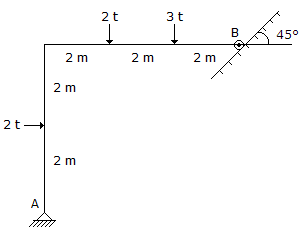Civil Engineering :: Applied Mechanics and Graphic Statics
- Which of the following represents the state of neutral equilibrium?
-
A square hole is made in a circular lamina, the diagonal of the square is equal to the radius of the circle as shown in below figure the shift in the centre of gravity is

- The potential energy of a particle falling through a straight shaft drilled through the earth (assumed homogenous and spherical) is proportional to (where r is the distance of’the particle from centre of the earth)
- A stone is whirled in a vertical circle, the tension in the string, is maximum
- The graphical method of determining the forces in the members of a truss is based on
- The shape of a suspended cable under its own weight, is
- The maximum value of the horizontal range for a projectile projected with a velocity of 98 m/sec is
- A geo-stationary satellite is one which orbits the earth with a velocity of rotation of
- A particle moving with a simple harmonic motion, attains its maximum velocity when it passes



 Whatsapp
Whatsapp
 Facebook
Facebook

